|
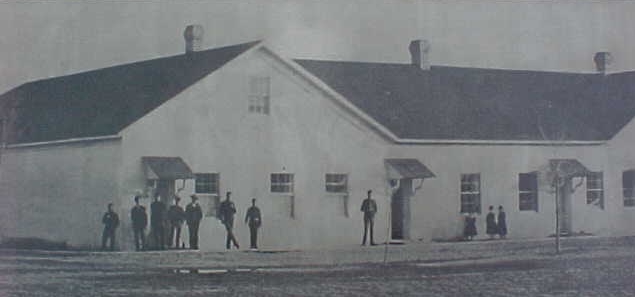
Administration Building, 1880's
The Administration Building was constructed in 1885 of a lime grout. As shown in
the next photo, the building is now in ruins. The building
in addition to housing the post adjutant's office, contained a library, school, and an
auditorium. Life on isolated posts in the West could be monotonous. Libraries and auditoriums provided
an opportunity for self-created entertainment. Elizabeth Custer in Boots & Saddle: Or Life in Dakota
With General Custer made note of such self-entertainment at Fort LIncoln:
The soldiers asked the general's permission to put up a place in which they could have
entertainments, and he gave them every assistance he could. They prepared the lumber in
the saw-mill that belonged to the post. The building was an ungainly looking structure,
but large enough to hold them all. The unseasoned cottonwood warped even while the house
was being built, but by patching and lining with old torn tents, they managed to keep out
the storm. The scenery was painted on condemned canvas stretched on a frame-work, and was
lifted on and off as the plays required. The footlights in front of the rude stage were
tallow-candles that smoked and sputtered inside the clumsily cobbled casing of tin.
The seats were narrow benches, without backs. The officers and ladies were always invited
to take the front row at every new performance, and after they entered, the house filled
up with soldiers. Some of the enlisted men played very well, and used great ingenuity in
getting up their costumes. The general accepted every invitation, and enjoyed it all
greatly. The clog-dancing and negro character songs between the acts were excellent.
Indeed, we sometimes had professionals, who, having been stranded in the States, had enlisted.
Anson Mills as a young captain describes in his 1918 biography
My Story being assigned in the 1870's to Fort D. A. Russell near Cheyenne. There he discovered that he had been
appointed as the "permanent chairman" of a committee. It was the first time that he had ever been
asked to asked to be the permanent chair of an Army panel. Unfortunately, it was the entertainment committee charged with putting on
monthly activities. Three young lieutenants were designated to plan and to assign roles for the first play,
Samuel Warren's tragic-comedy Ten Thousand a Year. The junior officers had their revenge. Captain
Mills found himself playing the lead of Tittlebat Titmouse, a draper's assistant who comes into
a fortune though the use of documents forged by his lawyers. Titmouse takes a seat in
Parliament, but is blackmailed by the lawyers. Thus, Mills discovered himself on stage in knee
breeches, cane, and wig made of angora wool. The significance of the wig is that Tidmouse's hair is
described as a "crop of busy, carrotty hair." In one scene from the novel upon which the play was based,
Tidmouse dreams of having black hair and, thus, goes to a chemist's shop for hair dye. Warren wrote,
"Titmouse bought the specific, hurried home, read with
delight the remarkable testimonials on the wrapper, and that night
rubbed the stuff into his hair, whisters, and
eyebrows with all the energy of hope." Warren continues:
"He could not sleep for several hours. He dreamed a rapturous dream, --that he bowed to
a gentleman with coal-black hair, whom he fancied he had
seen before, and suddenly discovered that he was only
looking at himself in a glass. This
woke him. Up he jumped, and in a
trice was standing before his little glass.
Horrid! He almost dropped down dead! His hair was perfectly green!--there was no
mistake about it. He stood staring in the
glass in speechless horror, his eyes and
mouth distended to the utmost, for several minutes. Then
he threw himelf on the bed, and felt
fainting. Up he presently jumped again,
rubbed his hair desperately and wildly about, again looking
into the glass; there it was, rougher than before;
but eyebrows, whiskers, and head, all were, if
anything, of a more vivid and brillant green."
[Writer's notes: It has been suggested that Warren's novel should be read by students of the law. See
"Samuel Warren: A Victorian Law and Literature Practitioner,"
C. R. B. Dunlop,
Cardozo Studies in Law and Literature, Vol. 12, No. 2
(Autumn - Winter, 2000) , pp. 265-291. The question may be asked whether in light of the
forgery or the blackmail of the client, whether the work is to be read in
conjunction with the classes on evidence or classes on ethics. Warren, himself, was a
lawyer. He served in Parliament and was appointed to a "mastership in lunacy." As noted by the 1911
edition of the Encylopedia Britannica, Warren was "a determined opponent of the rising school of
medical alienists who were more and more in favour of reducing certain forms of
crime to a state of aberration which should not be punished outside of asylums."]
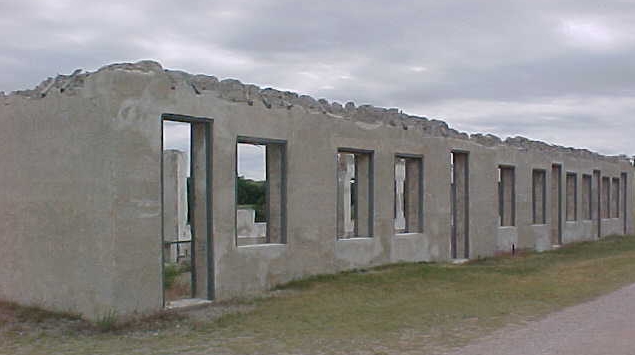
Administration Building, 2001, photo by Geoff Dobson
Other buildings which are now in ruins include the officers'
quarters depicted in the next photographs

Officers' Quarters, 1880's
The above buildings were also constructed of lime grout. The three buildings consisted of
two duplexes plus the commanding officer's quarters. Only the commanding officer's quarters
had inside plumbing. Each was constructed in accordance with a standard Army design utilized
elsewhere in the west, the only difference being materials. Compare with
view of officers' quarters at Fort Keogh below. Each side of the duplexes contained 1,250 sq. ft with sitting
room, parlor, dining room, and kitchen. The second floor had two or three bedrooms.
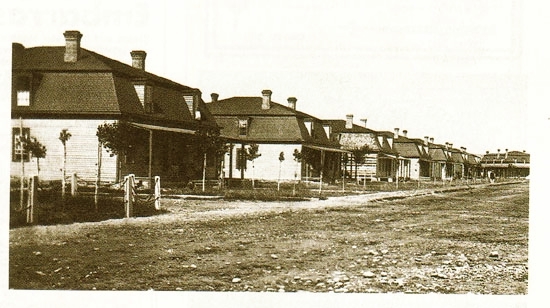
Officers' Quarters, Fort Keogh, Mont., undated
The Officers' Quarters at Fort Keogh were built of wood, while the buildings at
Ft. Laramie were of lime grout, a locally produced cement.
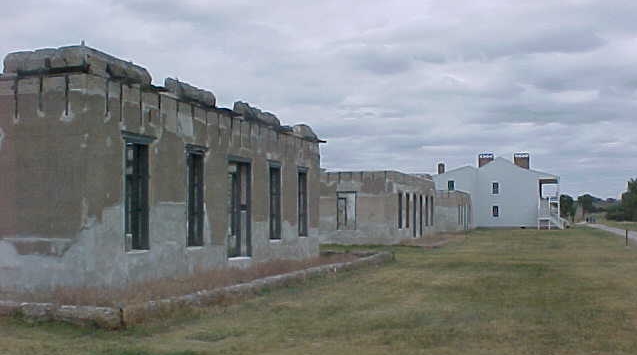
Officers' Quarters, 2001, photo by Geoff Dobson
Beyond the Officers' Quarters is "Old Bedlam."
The concrete houses were constructed in 1881 as additions to older, smaller structures.

Infantry Barracks, undated
At the left is the Infantry Barracks, constructed in 1867, located at the
northeast side of the Parade Grounds. The frame building housed three companies. In the center
of the photo is the "New" Guardhouse built in 1876 in response to complaints by the
post surgeon as to conditions in the old guardhouse. At the right hand side of the
photo is another infantry barracks constructed in 1866. Only foundations are left of the
two barracks buildings.
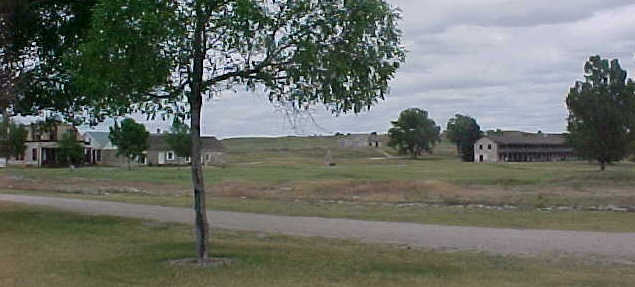
Infantry Barracks, 2001, photo by Geoff Dobson
In the foreground on the opposite side of the road, are the
foundations of the Infantry Barracks depicted at the left in the upper photo. In the distance on
the right is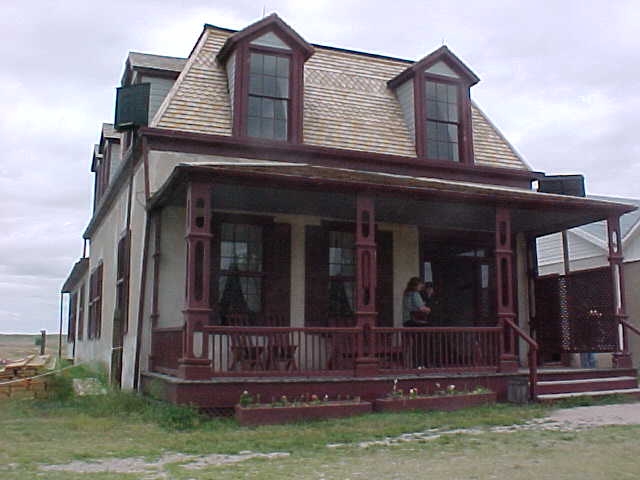 the Cavalry Barracks constructed in 1874. In the center of the photo on the hill are the
ruins of the post hospital, close-up on preceding page. At the left is the Sutler's Store, also
depicted on the preceding page.
To the left of the Sutler's Store is the Lt. Colonel's Quarters, now referred
to as the "Burt House" constructed in 1884 and named after Lt. Col. Andrew Burt, stationed at
Ft. Laramie twice. Burt also served as commander of Ft. C. F. Smith constructed to
protect the Bozeman Trail and also participated in the Battle of the Rosebud. The Burt House is noted for having housed the largest colony of bats at the fort. At one
time as many as 3,000 bats made their home in the house. Unfortunately, bat urine is highly acidic and
caused extensive damage to the house. The Park Service has now "bat proofed" and restored the structure. the Cavalry Barracks constructed in 1874. In the center of the photo on the hill are the
ruins of the post hospital, close-up on preceding page. At the left is the Sutler's Store, also
depicted on the preceding page.
To the left of the Sutler's Store is the Lt. Colonel's Quarters, now referred
to as the "Burt House" constructed in 1884 and named after Lt. Col. Andrew Burt, stationed at
Ft. Laramie twice. Burt also served as commander of Ft. C. F. Smith constructed to
protect the Bozeman Trail and also participated in the Battle of the Rosebud. The Burt House is noted for having housed the largest colony of bats at the fort. At one
time as many as 3,000 bats made their home in the house. Unfortunately, bat urine is highly acidic and
caused extensive damage to the house. The Park Service has now "bat proofed" and restored the structure.
Upper Left, "Burt House," photo by Geoff Dobson.
|